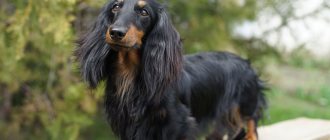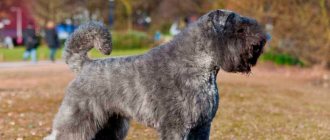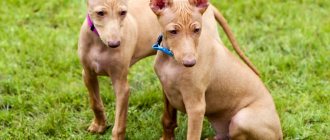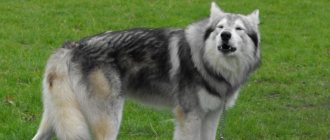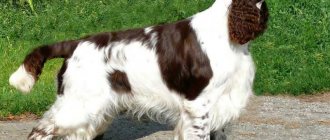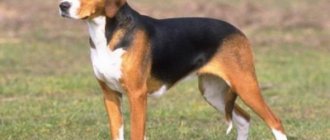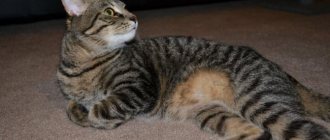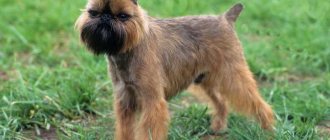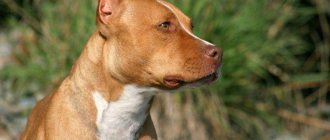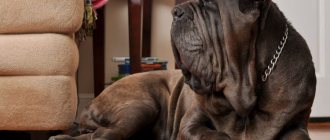Gray or, more correctly, blue pit bulls are very popular among fans of this breed.
These strong, stately and muscular dogs, reminiscent of silver or steel in color, look impressive and bright, especially if they have white markings.
Such a pet will become a devoted friend and reliable companion to a person who will spare no time and effort for its proper training and upbringing.
After all, a properly raised gray pit bull does not experience aggression towards people; it is quite intelligent and, at the same time, playful and active.
Origin story and what it looks like in the photo
The ancestors of gray pit bulls were bull and terriers, obtained from crossing Old English bulldogs with terriers.
From the first, these dogs inherited strength, strong physique, prominent muscles, courage, perseverance, as well as many colors, including white, black and blue. From terriers they received endurance, speed, intelligence, excellent reaction and tirelessness.
Until 1835, when a law was introduced banning the baiting of other animals by dogs, bull and terriers were widely used for fighting bears and bulls. Later, they began to be used as fighting dogs, pitting them against other dogs.
Despite the fact that such qualities as ruthlessness towards the enemy and malice towards other dogs were encouraged in dogs of this breed, aggression towards people has long been considered an unacceptable vice for them.
NOTE!
Animals that showed aggressiveness towards humans were, at best, excluded from breeding, and at worst, destroyed without regret.
Thanks to this, a breed was formed whose representatives could tirelessly fight the enemy, but at the same time did not show malice towards people.
Excellent reaction, speed and endurance made pit bulls also suitable as working and hunting dogs . And the fact that they were not naturally aggressive towards humans was the reason why they became popular as companion dogs.
However, the specific character and temperament of pit bull terriers create certain difficulties with the education and socialization of such dogs.
For a non-specialist, especially if this is his first dog, it is not always easy to cope with such a pet, therefore, currently, in order to have a pet of this breed, in most European countries you need to obtain a special permit.
Where did the pit bull come from?
Although the breed is called American, the dogs originally inhabited England, Holland, Spain, and Ireland. After some time, American breeders became interested in the pit bull; they artificially improved this breed for their own purposes.
Scientists believed that the dog lacked aggression, resulting in a species with a wide chest, small pointed ears and an attacking stance.
The breed was created for dog fighting, after which pit bulls were perfect as guard dogs for herds of cows and sheep, and they also perfectly guarded private homes.
People watched how fearlessly and mercilessly the pit bull tore apart the body of other weaker dogs, and now such a breed in people's minds looks terrifying, many people are afraid of them, afraid. After some time, a ban was issued on dog fighting with this breed.
The dogs that took part in the battles were exterminated, as they posed a serious danger to others. There have been accidents where pit bulls have killed people and even small children.
Residents of America did not allow the breed to spread; they took to the streets of cities with protests and rallies. After some time, breeders began to re-breed the breed; the new species had to be, first of all, friendly to humans.
Not all countries accepted these dogs; there they even became prohibited for breeding and existence.
Marriage or breed?
Gray color is not considered a fault of the breed; it is allowed by the standard and, moreover, is very popular among lovers of this breed.
Expert opinion
Kozhevin Semyon Kirillovich
Expert dog handler.
“Gray, or, in other words, blue color, is a lightened version of the black coat color. Such a pit bull can be either light, silver-gray, or dark, the color of wet asphalt. However, not only dogs with a bleached black color can look gray: often this shade of fur also occurs in blue brindle pit bulls, who have very few reddish brindle coats, which is why the dog looks almost completely gray. There are no particular difficulties when caring for them, however, owners of gray pit bulls need to take into account that animals with this color are often predisposed to allergies.”
Breed characteristics
Breeders divide pit bulls into bulldog, terrier and mixed types. The weight of the animal can be up to 36 kg for males and up to 30 kg for females. Actually, the mass itself, like the height of the dog, depends directly on the bone structure. Pit bulls have a square head, with a flat and fairly wide forehead, slightly saggy cheeks, without folds. Some individuals have pronounced eye sockets. The dogs' jaw is strong and deep, with large teeth that fit tightly together. The ears are set wide and high, the eyes are almond-shaped, oval or round, set wide. The nose is not upturned, dense, with wide nostrils. The neck is short and muscular, the shoulders are broad. The back is flat, wide, and the groin line is tucked. The body is completely covered with dense skin without folds. The limbs and tail are of medium length.
Character traits
Gray pit bull terriers are strong, self-confident, hardy and agile dogs. They are distinguished by a lively, energetic and moderately inquisitive disposition.
Modern pit bull terriers
are friendly towards people, including children .
At the same time, they are fearless and tireless in battle with the enemy. The fact that these dogs were bred to fight other animals has caused innate animal aggression, which needs to be properly corrected through early socialization and education.
However, a well-bred pit bull that has no mental problems and comes from healthy lines can be considered a completely reliable companion and family friend.
The behavioral characteristics of representatives of this breed largely depend on how the dog was raised and in what conditions it was kept, which is why you can often hear conflicting opinions about pit bulls.
Some people consider these dogs to be the kindest and most peaceful creatures in the world, while others consider them to be ruthless fighting machines whose goal is to destroy the enemy.
In fact, the character of gray pit bulls is very multifaceted and even somewhat contradictory, so that it depends only on the owner what kind of dog his dog will grow up to be: affectionate and good-natured, or prone to behavioral breakdowns and causeless aggression.
American Pit Bull Terrier - killer dog or not
There is probably not a single breed whose attitude towards it would be so contradictory. There are two mutually exclusive opinions about this dog. Admirers of the breed claim that pit bull terriers do not pose any danger to others. Opponents are shouting at every corner that this is a soulless killing machine. So what is true and does this breed have a right to exist in our world?
Over the many years that the animals live nearby, their character has changed. The dog became more friendly and balanced. Love for an owner is not an empty phrase for an animal; if necessary, a pet will rush to protect a loved one, risking its own life.
Education and training still play a very important, if not the main, role!
Only by paying enough attention to your pet and spending time and effort on raising it, you can get a balanced dog with a stable psyche. An indifferent attitude and a constant lack of time can lead to very sad consequences. The animal will indeed become disobedient, aggressive and may even attack people.
By nature, pit bulls are quite peaceful creatures. Late socialization, the presence of various fears and a complete lack of upbringing will make it so that those negative qualities that people artificially cultivated in them many years ago will begin to predominate.
A Pit Bull should not be treated intentionally roughly. He desires affection and love, like any other animal.
Advantages and disadvantages
Pros:
- Beautiful and elegant appearance.
- Suitable for keeping in an apartment.
- Hardy and unpretentious.
- Strong and brave.
- A good guard.
- He is in fairly good health.
- Smart, intelligent and well trained.
- Can be trained in any sporting discipline suitable for a dog of this size.
- They are friendly towards people and love children.
Minuses:
- They need professional training and great physical activity.
- May be aggressive towards other animals, including other dogs and cats.
- Not recommended as a first dog.
- They cannot live in the yard all year round.
- They do not tolerate prolonged loneliness well.
- Sometimes they can show stubbornness, sometimes reaching the point of obstinacy.
Gray pit bulls should not be set against people and should not be trained in disciplines that involve aggression towards humans, such as apprehending trespassers.
Caring for a pit bull
Pit bulls live in apartments, but require active games (jogging in the park, playing on playgrounds, with a ball, stick, frisbee). Dogs of this breed are good with people, especially children. They are demanding of attention, value their owners, care and love. Reliable companions. When chained in suburban areas, they quickly run wild and become vicious, although they are suitable for protecting a home.
The dog will need long walks (hour walks three times a day) and exercise. Pit bulls are agile and can climb, climb and scramble. It is worth looking at a nearby area for animals or replacing it (slide, wall, tree, safe buildings).
Dimensions, weight and other distinctive features
- Height . Males - from 46 to 53 cm. Females - from 43 to 51 cm
- Weight . Males - 16-27 kg. Females - 14-23 kg.
- Head . Medium in size, proportional to the body, shaped like a rectangle. The skull is moderately wide and somewhat flattened in the frontal region, the cheekbones are pronounced. The jaws are well developed, strong and strong.
- Muzzle . Square in shape, voluminous and quite wide.
- Ears . Semi-erect or rose-shaped, set high. As a rule, pit bulls' ears are cropped.
- Eyes . Low set, round or almond shaped. Eye color is usually brown in various shades, sometimes it can be light amber.
- Neck . Strong, dry, well muscled, somewhat widening towards the withers.
- Shoulder blades . Muscular, set askew.
- Back . Slightly sloping towards the tail, quite wide and strong, but not long.
- Rib cage . Sufficient depth and volume.
- Forelegs . Strong, parallel and straight.
- Hind limbs . Strong, with regular angles of articulation and well-defined muscles on somewhat elongated thighs.
- Tail . Short and low set, wider at the base and tapering towards the end. Usually carried either lowered or raised no higher than the line of the spine.
- Wool . Close-lying, rather hard and short with a characteristic shine, no undercoat.
The body type of a dog depends on what type it belongs to: bulldog, terrier or intermediate, which is considered the standard for this breed.
Gray bulldog-type pitbulls look more massive and muscular, they have relatively wide heads and muzzles and may even have an undershot.
Terrier-type dogs are relatively tall-legged and lighter, and their heads and muzzles are usually narrowed.
Dog appearance (standards)
Dimensions
A pit bull dog has an average height of 44 to 49 cm. The weight of an adult dog is 20-30 kg.
Wool
The animal's coat is short and coarse, lying tightly to the body. There is no undercoat.
Colors
The standard allows any type of color. The only thing unacceptable is uneven coloring of the coat, manifested in the form of dark and light spots of the same color.
Head
The photo of the pit bull shows that its head has a pronounced square shape.
Teeth and jaws
The jaws are powerful and have a scissor bite. The teeth are evenly spaced and white.
Eyes
A pit bull's eye color can be any color. The shape is almond-shaped.
Body and limbs
The body of the animal is powerful and muscular. The body can be represented in the shape of a rectangle. The limbs are long and strong, stable.
Tail
The tail is relatively short, set low. Thick at the base, tapering towards the tip.
Rock defects
The defects include the following:
- uneven color;
- presence of long hair;
- malocclusion;
- short tail;
- cryptorchidism;
- deafness;
- excessive aggressiveness or, conversely, timidity.
Shades of Gray in Pit Bulls
- Blue . The color of the coat can be grayish-blue in various shades from light silver to dark graphite. There may also be small white markings.
- Blue-white . With this color, on the main bluish-gray background there are white markings, occupying no more than 50% of the area.
- Blue brindle . While not a bleached black color, the blue brindle coat color may appear grayish blue if the red brindles occupy a small surface area and are few in number.
- Blue-fawn . The main color of the coat is fawn or red, but due to the fact that there is a grayish-blue coating on the dog's body, this color may appear gray.
- Blue and tan . On the main grayish-blue background there are tan marks of a reddish or fawn color.
- Tricolor . This is the same blue and tan coloring, complemented by white markings.
- Isabella . The color is reminiscent of a café au lait hue and, depending on the shade, can appear almost blue with a slight golden or pinkish tint.
Other colors can also visually look gray, for example, Isabella brindle, as well as pale fawn with a blue mask.
In addition, the blue colors also include the blue merle color, which is prohibited in this breed, in which uneven black spots are located on a light gray background, often complemented by white markings.
What does the breed look like?
At first glance, the Pit Bull Terrier is a strong-willed dog, distinguished by its strong body and health. Specialists worked on the body specifically to make it massive and muscular.
The difference between a pit bull and other breeds can be identified by its special body structure.
The general characteristics of the breed are:
The coat color of such dogs can be absolutely any color except white. The most common coat color is all shades of brown, most often with light highlights. The fur itself is short, smooth, and in some individuals it has a healthy sheen and gloss.
Pit bulls have a large, wedge-shaped head with wide jaws.
The dog's body is massive, dense, muscular, the chest area has a wide structure. The paws are large, wide as are the hips. The tail is not long, wide at the base, tapering towards the end.
Adults can weigh up to 38 kg - males, females weigh up to 23 kg. The height of pit bulls varies from 36-42 cm.
The most popular dog names in alphabetical order with recommendationsShar Pei - history of the breed, character traits, care and possible problems + 87 photos
American Bulldog - history of the breed, appearance, specifics and characteristics, care (100 photos + video)
Life expectancy and what diseases are they susceptible to?
Gray pit bulls live 12-15 years and are usually in good health.
Representatives of this breed are susceptible to only a few diseases, such as:
- Von Willebrand's disease.
- Bloating and volvulus of the stomach or intestines.
- Joint dysplasia.
- Aortic stenosis.
- Hypothyroidism.
- Cutaneous hemangioma and histocytoma.
- Cataract.
Gray pit bulls are more susceptible to allergies, including food allergies, than dogs of other colors.
Raising and training dogs
Numerous breeders and dog handlers claim that pit bulls remember various complex and simple commands quite easily and are very easy to train.
To train a pit bull to be obedient, you first need to complete an initial training course. After mastering this simple knowledge, the owner will be able to teach his pet any complex commands, thanks to which the dog will learn to control his aggression, and the owner will learn to control the dog.
When raising an animal, you need to be consistent in your actions. Dogs of this breed can become stubborn if they feel insecure during training on the part of their owner.
You cannot develop aggression towards surrounding strangers in a pit bull. Over time, the dog will become uncontrollable and the spirit of a fighter will awaken in it. Such a dog will be a real threat to strangers, because he doesn’t just attack, biting anywhere, but chooses weak points in the human body. Thanks to its strong teeth, the dog has a death grip on its victim and can cause serious harm to human health. That is why the dog should never be taught to behave aggressively.
Basic rules of care
The pet's coat should be combed with a brush or mitt for short-haired dogs approximately once a week.
Gray pit bulls are bathed no more than once every two months, and given the allergic nature of this breed, special hypoallergenic shampoos should be used.
Eyes and ears are examined every day and cleaned as needed..
IMPORTANT!
To encourage your dog to clean his teeth, you can give him treats to remove plaque or chew toys.
You can also brush your pet's teeth with dog toothpaste applied to a toothbrush.
Claws, if necessary, are shortened using a nail clipper, although pit bulls usually grind them down themselves when walking on hard surfaces..
Care and maintenance
There are no excessive requirements for the care and maintenance of American pit bull terriers.
Pit cats have short fur and are brushed twice a year during seasonal shedding. The rest of the year, they simply tidy up by lightly combing and removing dirt.
The claws wear down on their own during long walks. If they are long and interfere with walking, trim them with a nail clipper. Ears are treated as they become dirty.
Oral care will help maintain white teeth and eliminate unpleasant odor in the mouth. It is easier to teach a dog to brush its teeth (with toothpaste, as it should be!) from an early age.
Bathing is enough 2 times a year. The dog tolerates this procedure very calmly. Place a rubber mat on the bottom of the bathtub to prevent your dog from slipping and scratching the bathtub. You can add a little water so that it barely covers your paws. Now we water the four-legged animal, avoiding getting its head and ears wet. Lather the shampoo into foam and apply to the coat (do not pour shampoo on the dog!), stroke the dog with this foam, and then rinse. You can dry the wool with a hairdryer with a warm jet or wipe it with a towel. Leave your pet at home for 2-3 hours after bathing and let him dry completely. It is not recommended to bathe pregnant, old, or sick dogs. If you bathe frequently, your skin may begin to crack due to dryness. So don't overdo it!
In summer, pitas willingly swim in ponds. Choose places where there are no people (observe hygiene rules!). If the dog does not dare to go into the water, set an example for it - take a swim first and call it to you. Don't forget to take off your collar! After each walk, the paws are washed in a basin and the belly is wiped with a damp cloth.
How to choose?
You should purchase a puppy from a kennel or through a club of those cynological organizations that recognize this breed.
At the same time, it is very important that the parents of the future pet have a stable, balanced psyche, come from healthy lines and have the appearance, character and temperament typical of the breed.
If you plan to purchase a show-class dog, then it is better to opt for an intermediate pit bull, rather than a bulldog or terrier type.
When choosing a baby from the litter, you need to carefully check whether he has any visible signs of ill health: discharge from the ears or nose, skin rashes or redness.
The puppy should be cheerful, active and moderately mobile, showing friendly curiosity towards people, but not cowardice or aggression.
It is not recommended to purchase a gray merle pit bull, as this color may be genetically linked to mental or health problems in the dog.
Character
Despite all its advantages, this dog causes distrust on the part of many people. If you take Sweden, breeding pit bulls is strictly prohibited there. This was also done in some states of America. In other countries, walking these animals is allowed only with muzzles.
The character of a pit bull dog has been formed over a long period. Today this dog has a friendly and balanced temperament. But the hunting instinct has been preserved, thanks to which the dogs cope well with the role of guarding premises, and are also excellent assistants during the hunt.
Pitbull has the following character traits:
- The desire to constantly be useful to the owner - childishly playful, the pit bull at the same time notices all the needs of its owner. Even if he is unwell, the dog will do everything in his power to become useful and earn gratitude.
- Confidence in his own merits - such a noble feeling of a dog is manifested in the fact that even knowing about his superiority, he will never attempt to show it to the members of the family in which he lives.
- Attentiveness and extraordinary prudence - even pit bull puppies have these character traits. Even as children, they want to appear mature and wise.
- Showing favor towards children - a dog of this breed is characterized by strong devotion to its “pack”, be it dogs or people around it. She behaves very carefully with them and will never bite a child, no matter what he does to her.
Pit bulls are good family dogs and can perform a wide range of different services.
Those individuals with mental disorders were not allowed for breeding. Indeed, pit bull puppies, photos of which you can take a good look at here, can turn into dangerous animals if they are not raised correctly. Therefore, animals that could not control themselves and did not distinguish a person from a dog were destroyed. According to this principle, the gradual formation of the breed took place.
Price range
The price of pit bull terrier puppies varies depending on the class to which they belong, and on average is 4-15 thousand rubles. Adults who have won prizes at exhibitions and puppies with a pedigree and registration in international associations are valued more highly.
This breed is not recognized by the RKF, so the puppies cannot have Russian ancestry.
